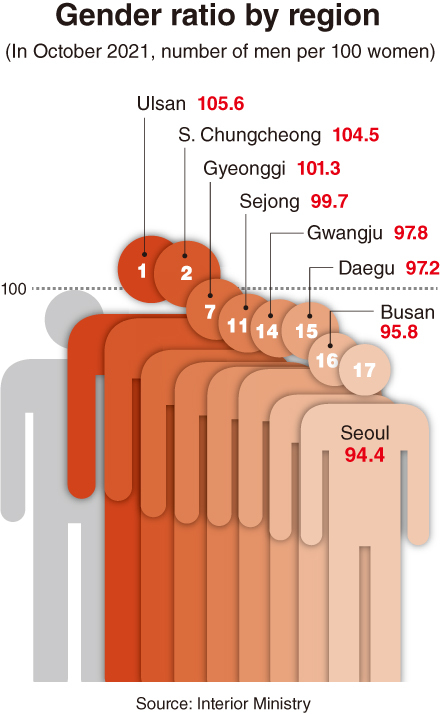 |
A view of Gwangbok-dong, Busan. Of 17 major areas in Korea, the city posted the second-lowest gender ratio, 95.8, in October, in which women outnumbered men by more than 71,000. (Yonhap) |
SEJONG -- The number of men and boys in South Korea has continued to decline since August 2019 on a monthly basis, which has led the gender ratio -- the number of men per 100 women – to fall to an all-time low, government data showed.
It has been found that Seoul and Busan -- the nation’s top two populous cities -- have taken the initiative in widening the gender disparity in demographic figures.
According to the data held by the Ministry Interior and Safety, the male population posted 25.76 million in October, down 3,653 from a month earlier. The figure was the lowest in almost six years, since it stood at 25.75 million in December 2015.
 |
(Graphic by Han Chang-duck/The Korea Herald) |
After peaking at 25.86 million in July 2019, the male population has continuously declined. The female population has both risen and fallen on-month in recent years.
Seoul had the biggest decrease in the men’s population in October, falling 5,439 on-month to 4.63 million. The capital has led the nationwide decline in demographic figures for both men and women over the past two years.
Among the 17 major cities and provinces, Seoul posted the lowest ratio of men to women, 94.4 per 100 or 4.63 million to 4.9 million as of last month. Women in the capital have outnumbered men for more than a decade.
Busan placed second-lowest with a sex ratio of 95.8, followed by Daegu at 97.2. Gwangju ranked fourth-lowest with the ratio of 97.8, followed by North Jeolla Province at 98.9, Daejeon at 99.6 and Sejong at 99.7.
Though the nationwide gender ratio also fell to the record-low of 99.4 (25.76 million men vs. 25.9 million women), the remaining 10 of the 17 major areas are still majority male.
Ulsan, a manufacturing-oriented city, posted the highest male-to-female ratio of 105.6. The next on the list were South Chungcheong Province with 104.5, North Chungcheong Province with 102.9 and North Gyeongsang Province with 101.5.
Gyeonggi Province -- the nation’s most populous area with 13.54 million as of February -- posted a male-to-female ratio of 101.3.
“The disparities stem from regional characteristics such as urbanization and the presence of farming communities, service industries, military zones and manufacturing towns,” a government official said.
Women began outstripping men in June 2015, with 25.7157 million female Koreans as against 25.7153 million for males -- the first time in history it had dropped below 100.
The reversal in the gender ratio could be attributable to women’s longer lifespan compared to men.
Interior Ministry data showed that the number of men in their 70s was 1.67 million across the nation as of October 2021, while the figure for women in the corresponding age group tallied 2.03 million.
The demographic disparity was even more pronounced for people aged 80 and over: The figures for those in their 80s were 646,000 (men) to 1.17 million (women). For those in their 90s, the gulf was still wider at 57,000 to 203,000 and for centenarians it was 2,099 to 8,190.
In Korea, a preference for sons has made the gap between the number of newborn boys and girls artificially high. But this childbirth gap has been narrowing as the preference for sons has waned.
The ratio of boys born per 100 baby girls exceeded 110 in the 1990s, according to some unofficial statistics. In contrast, the sex ratio among newborns was 104.8 -- 10,844 boys to 10,343 girls -- last month, according to the ministry.
By Kim Yon-se (
kys@heraldcorp.com)









![[Weekender] Korea's traditional sauce culture gains global recognition](http://res.heraldm.com/phpwas/restmb_idxmake.php?idx=644&simg=/content/image/2024/11/21/20241121050153_0.jpg)